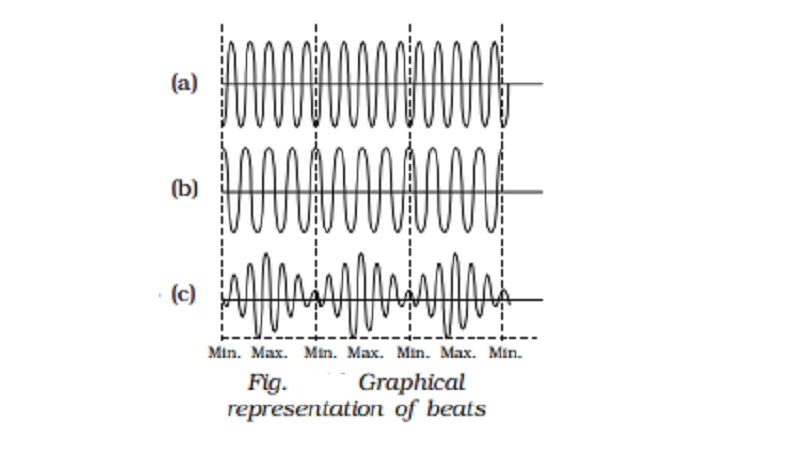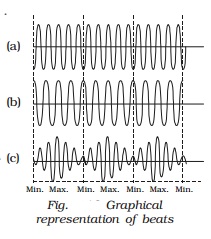Chapter: 11th 12th std standard Class Physics sciense Higher secondary school College Notes
Beats - Analytical method and Uses of beats

Beats
When two waves of
nearly equal frequencies travelling in a medium along the same direction
superimpose upon each other, beats are produced. The amptitude of the resultant
sound at a point rises and falls regularly.
The intensity of the
resultant sound at a point rises and falls regularly with time. When the
intensity rises to maximum we call it as waxing of sound, when it falls to
minimum we call it as waning of sound.
The phenomenon of waxing and waning of sound due to interference
of two sound waves of nearly equal frequencies are called beats. The number of beats produced per second is called
beat frequency, which is equal to the difference in frequencies of two waves.

Analytical method
Let us consider two
waves of slightly different frequencies n1
and n2 (n1 ~
n2 < 10) having
equal amplitude travelling in a medium in the same direction.
At time t = 0, both
waves travel in same phase. The equations of the two waves are
y1 = a sin ω1t
y1
= a sin (2π n1)t ...(1)
y2
= a sin ω2 t = a sin (2π n2)t ...(2)
When
the two waves superimpose, the resultant displacement is given by
y
= y1 + y2
y
= a sin (2π n1) t + a sin (2π n2) t ???(3)
Therefore
y
= 2a sin 2π (n1+n2 / 2)t. cos 2π(n1-n2
/ 2)t ??(4)
Substitute
A = 2 a cos 2π(n1-n2 / 2)
And
n=(n1+n2)/
2 in equation (4)
∴ y = A sin 2πnt
This
represents a simple harmonic wave of frequency n = (n1+n2
/ 2) and amplitude A which changes with time.
(i)
The resultant amplitude is maximum (i.e) ? 2a, if
cos
2π[( n1-n2 )/ 2]t=? 1
2π[(
n1-n2 )/ 2]t = m π
where
m = 0, 1, 2 ...) or (n1 ? n2) t = m
The
first maximum is obtained at t1 = 0
The
second maximum is obtained at
t2
= 1/(n1-n2)
The
third maximum at t3 = 2/(n1-n2) and so on.
The
time interval between two successive maxima is
t2
? t1 = t3 ? t2 = 1/(n1-n2)
Hence
the number of beats produced per second is equal to the reciprocal of the time
interval between two successive maxima.
(ii)
The resultant amplitude is minimum (i.e) equal to zero, if
cos
2π ( (n1-n2) /2)t=0
(i.e)
2π ( (n1-n2) /2)t= π/2 + m π
where
m = 0, 1, 2 ...
The
first minimum is obtained at
t1′
= 1 /[2(n1-n2)]
The
second minimum is obtained at
t2′
= 3 /[2(n1-n2)]
The
third minimum is obtained at
t3′
= 5 /[2(n1-n2)] and so on
Time
interval between two successive minima is
t2′
- t1′ = t3′ ? t2′ = 1/ (n1-n2)
Hence,
the number of beats produced per second is equal to the reciprocal of time
interval between two successive minima.
Uses of beats
(i) The phenomenon of
beats is useful in tuning two vibrating bodies in unison. For example, a
sonometer wire can be tuned in unison with a tuning fork by observing the
beats. When an excited tuning fork is kept on the sonometer and if the
sonometer wire is also excited, beats are heard, when the frequencies are
nearly equal. If the length of the wire is adjusted carefully so that the
number of beats gradually decreases to zero, then the two are said to be in
unison. Most of the musical instruments are made to be in unison based on this
method.
The frequency of a
tuning fork can be found using beats. A standard tuning fork of frequency N is
excited along with the experimental fork. If the number of beats per second is
n, then the frequency of experimental tuning fork is N+n. The
experimental tuning fork is then loaded with a little bees? wax, thereby
decreasing its frequency. Now the observations are repeated. If the number of
beats increases, then the frequency of the experimental tuning fork is N-n, and
if the number of beats decreases its frequency is N + n.
Related Topics